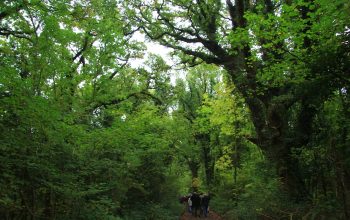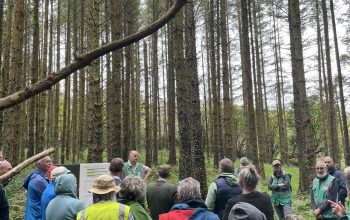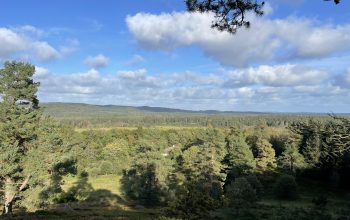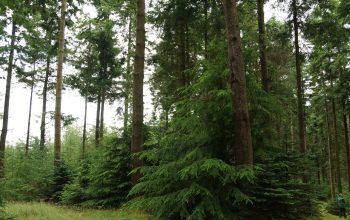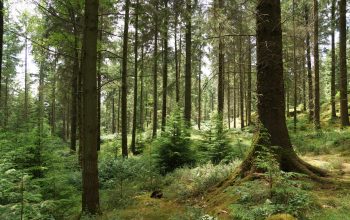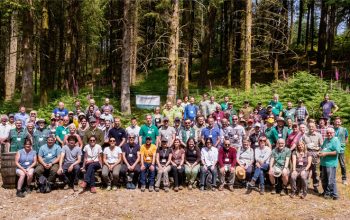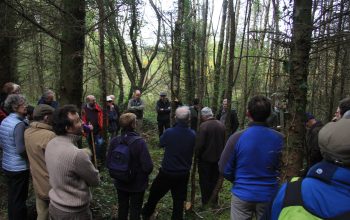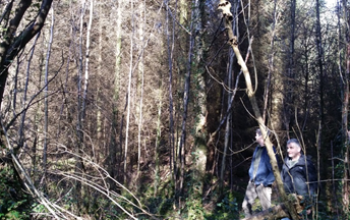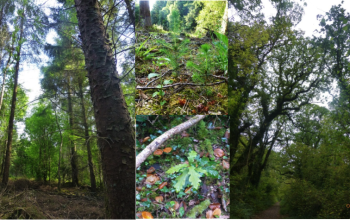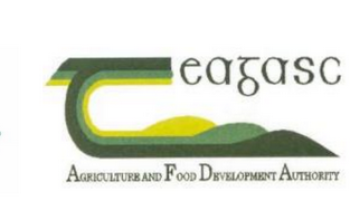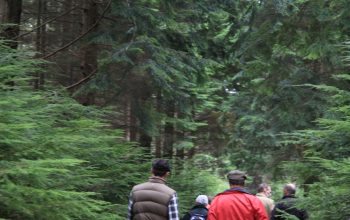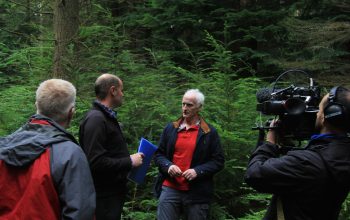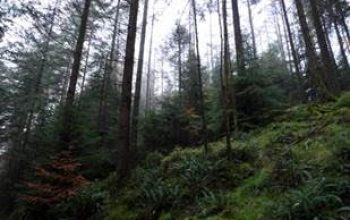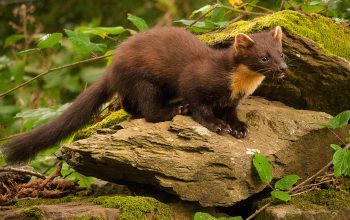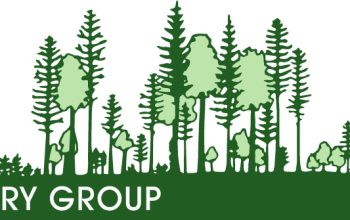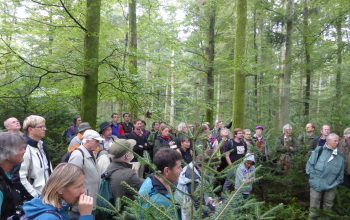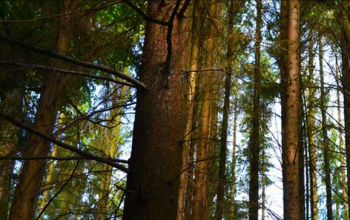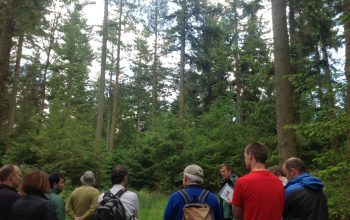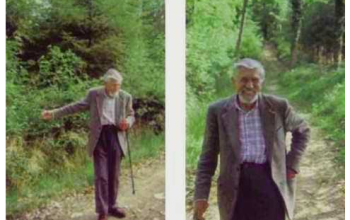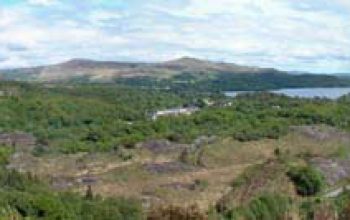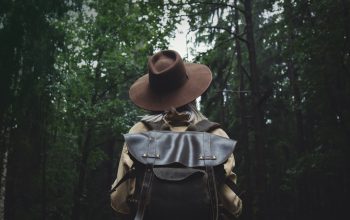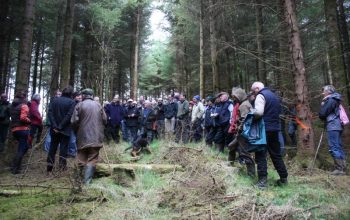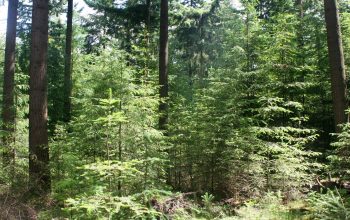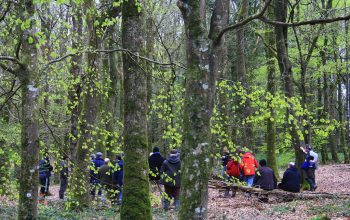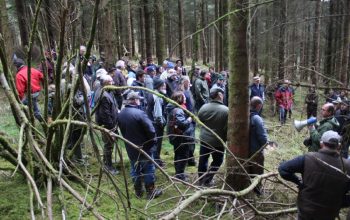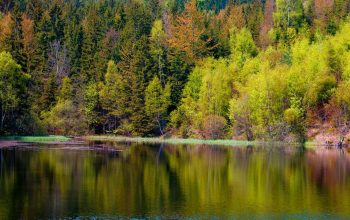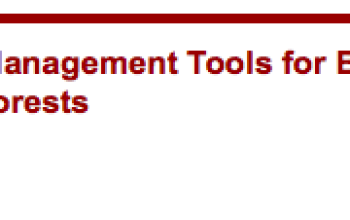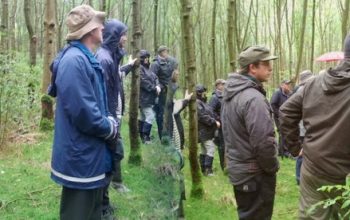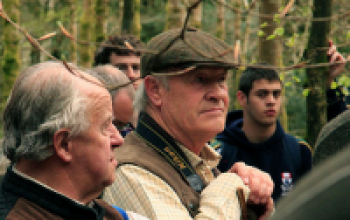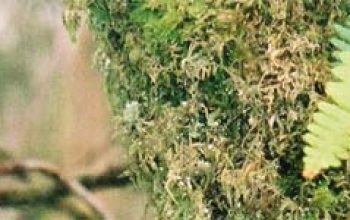by Padraig O Tuama, Pro Silva Ireland

Photo 1 – Participants from seven countries attending workshop (Photograph -Eckart Senitza)


Photo 2 – Irish contingent – Kieran O Connell, Fionan Russell, Paul Finnegan, Tomas Hanrahan, Padraig O Tuama, Andy Dunne, Padraig Dolan, Ted Wilson. (Photograph – Ted Wilson)
Exemplary Forest Units of Uneven-Aged Forestry in the Czech Republic.
On 24th October eight of us, Padraig O Tuama, Padraig Dolan, Fionan Russell, Tomas Hanrahan, Kieran O Connell, Paul Finnegan, Ted Wilson and Andy Dunne travelled to the Czech Republic to attend a CCF conference being held by Pro Silva Bohemica. After arrival in Prague airport we rented a mini-bus and travelled together to the Hotel Medlov in the Kocanda District about two and half hours travelling east of Prague close to the district town, Žďár nad Sázavou. Below is the blurb on the invitation to attend the work shop in Kocanda District. The workshop structure was forty per cent presentations and sixty per cent visit in the forest where we could see demonstration of forest transformation in practice. The attendance was made up of approximately eighty Czech foresters, eight from Ireland with representatives from Germany, Austria, Poland, Slovenia, Sweden and Switzerland.
| Title: Exemplary Forest Units of Uneven-Aged Forestry in the Czech Republic
Sub-title: 25 years of pure even-aged Norway spruce stands transformation and Pro Silva principles application within the Forest District Kocanda. Main Targets:
Risks to our forests are increasing due to climate change effects in combination with the consequences of historical forest management practices. There is an obvious need to change present forest management practices. The importance to divert from silvicultural systems of coniferous stands that are homogenous in tree species composition and age was identified more than a hundred years ago. Even then there was sound evidence that even aged, single species forests were sensitive to forest disturbances caused by both biotic and abiotic factors. However, there are forest in the Czech Republic where the transformation process has been applied for the last few decades. The first results of the long transformation process to achieve stable, mixed and heterogenous stands effectively using self-regenerating, organizing and regulating processes and natural automation can be demonstrated in these forests. This process is of interest beyond the Czech Republic as many countries in Europe are facing the same situation and the need for transformation. |
Why was this conference being held, now, in the Czech Republic? There is great concern in the Czech Republic and across central Europe regarding the forest health in general. The effect of droughts across Europe over the last number of years has been very significant, affecting Norway Spruce mono-cultures in particular. These forests are in a weakened state and are prone to spruce bark beetle attack affecting large areas of forests. Wind disturbances are also having a major effect. Up to 30% of the annual cut in a forest may be taken up by salvage cuttings from windthrow and bark beetle clearances. As age-class management utilising shelterwood systems giving structured projected forecast volumes and regulations about allowable sustainable cut this has significant impact on the structured forest management plans. There is also significant commentary in the media and in society in general about the health of the forests and how they are being managed.
Day one – 25th October.
This was primarily an indoor session up to about three o’clock with an excursion to virgin forest reserve Žákova hora from three to half six. There were nine separate presentations broken into three separate sessions.
Introductions
In his introduction to the conference, Milan Hron, President of Pro Silva Bohemica, outlined the concern that cultivating homogenous mono-specific forest is risky practice today and will be more so in the future if we are to learn anything at all from the past. Even within the same sensitive species different individual trees of different ages show differing resistance to each detrimental factor making the point that it is now being accepted that uneven-aged forest cover reduces risk of damage or even total destruction. He raised the question why we don’t have more uneven-aged forests citing reasons given as perceived complexity, too long for transformation, unattainable ideals when especially selection forest in considered as the final target and legal restrictions in place. He stated that by following a few simple principles and setting lower and less ambitious goals than pure selection forest one could make a start straight away. The best example is the forest that has been managed by Jiří Bína in Kocanda that we will spending our time in following day showing tangible results after twenty-five years.
Constantin Kinský, owner of the forest area in Kocanda, in welcoming the gathering stated at the outset that “Our forests are managed forests” and “are where we manage nature in such a way that we can make a profit to sustain people living from them today”. He challenged us to leave our ideological preconceptions at the border and enter the forests with our eyes, ears, minds and our hearts wide open and to learn together from the forests.
Eckart Senitza, President of Pro Silva Europe welcomed the conference as a catalyst to bring together science, public and forest practice which should work close together on all aspects of forestry. Eckart spoke of the three-legged approach of Economic, Environment and Social aspects of Pro Silva forest management but stressed the importance the economic aspect and the financially viable of the style of management that is often overlooked.
Finally, the spokesperson from the Ministry of Agriculture, Tomáš Krejzar, outlined the threat to the Czech forest estate saying that due to drought, bark beetle and climate change there was “a fight for life of Czech Forests”. He very much welcomed the conference saying that this form of approach to forest management is “not just something that would be nice to do but something we have to do”.
Andreas Schuck, European Forest Institute (EFI) SURE project, co-organizer of the conference welcomed the participants from the eight countries across Europe. Andreas spoke of EFI’s involvement in establishing European Forest Risk Facility and that it was because of this “risk” element that they were supporting this conference. He spoke of Pro Silva Bohemica’s and its wider Pro Silva network had been a supportive partner in the visions of Forest Risk Facility. Increasing Forest risk understanding and forest resilience to mitigate unwanted effects of disturbances in the forests.
Section 1: This section consisted of three papers that set out some of the rationale for pursuing CCF management in the forests.
SUSTAINABILITY OF FOREST MANAGEMENT FROM THE VIEW OF MAINTAINING A NUTRIENT BALANCE – AN EXAMPLE FROM THE ŽĎÁRSKÉ VRCHY AREA
Vít Šrámek The Forest and Game Management Institute, Czech Republic.
In this paper we were forewarned with risks associated with over intensive use of forest management in unsuitable habitats from the last century. Less resistant forests have succumbed to serious damage from the Bark Beetle, and in recent years the annual cut in spruce has seen dramatic increases with large timber volumes hitting the market with resulting decreases in timber price. Also addressed was the effects of acid rain on soils in the forest, even though the effect is now much reduced excessive level of nutrients are still present. The effects of the deposits and the previous management are showing changing levels phosphorous and magnesium levels in the soil and changing optimal conditions for regeneration. The continuing single species forest are not helping the situation and recommend introduction of broadleaf species with deep roots and falling leaves assisting nutrient recycling.
WOOD FORMATION AS AN INDICATOR OF WATER TRANSPORT IN DROUGHT-STRESSED TREES
Petr Horáček -Global Change Research Institute of the Czech Academy of Sciences, Brno, Czech Republic.
This paper addressed research on the effect of drought on forests. Dry air and dry soils are lethal for transpiration -huge increase in pressure causes collapse in cells and trees die (Pressure in a tree is 10 times higher than in a car tyre). Irregular structure helps control wind-flow leading to managing transpiration – the comment being made being this was an example of science confirming intuition. The introduction of broadleaves in forests was recommended as broadleaves are more efficient with water retention and transpiration.
THE CLOSE-TO NATURE FOREST REGENERATION AFTER A LARGE DISTURBANCE
Antonín Martník – Faculty of Forestry and Wood Technology, Department of Silviculture, Mendel University, Brno, Czech Republic.
Antonín addressed how does one adopt close to nature forest management following large disturbances from storms or from large scale salvage cuttings as the result of bark beetle (or a clear-felled area in an Irish context). He argued, that as an alternative to directly establishing the climax species, that pioneer species should be allowed to regenerate naturally and develop primarily with the introduction of the climax species soon after the establishment of the pioneer species. The climax species could be introduced as an understory later in the cycle when the pioneer species is being thinned mimicking natural processes that occur in the forests. He argued that this will produce a more stable, resilient forest that will be of higher value to the owner in the long term. He also challenged the legislative regulations of only allowing a shorter regeneration phase and proposed a longer regeneration phase to allow for adoption of close to nature forestry.
Section 2: After coffee break three different aspects of CCF from different countries were presented.
EXEMPLARY FORESTS UNITS OF UNEVEN-AGED FORESTRY, PRO SILVA BOHEMICA
EXEMPLARY FOREST UNIT 201710 KOCANDA, EXEMPLARY AREA 201710A KOCANDA
Jiří Zahradníček- Freelance Czech Forester, Brno, Czech Republic.
This paper was presented by Milan Hron, president of ProSilva Bohemica in the absence of Jiří Zahradníček. The purpose of establishing Exemplary Forest Units of Uneven Aged forestry (DOHN) is to show forest owners and managers ways to achieve more economical and nature-based uneven-aged forestry. Milan outlined the process for selection of a DOHN and the policy of ProSilva Bohemica to have series of DOHN across the Czech Republic and across a range of different forest site types. There is a strict inventory protocol to be established in the DOHN to inform, through repeated inventories a range of parameters such as growing stock, basal area, species, diameter classes and stages of regeneration. Presently, establishing DOHN in private forest is supported by Ministry of Agriculture and it is proposed to have a network of fifty across the Czech Republic. Milan outlined that Forest of Kocanda was selected as a DOHN in 2017 and gave details of inventory information collected.
Having Exemplary Demonstration is a concept promoted by Pro Silva Europe with the ambition of having these demonstration forests across all Pro Silva Europe participating countries. In Ireland we do have the range of AFI sites that may be selected for Exemplary forests, but it is a process that we in Pro Silva Ireland will be putting in place in the future.
TRANSFORMING SITKA SPRUCE PLANTATIONS TO CONTINUOUS COVER FORESTRY IN IRELAND
Edward Wilson, Teagasc Forestry Development Department, Ashtown, Co. Dublin, Ireland
In his paper Ted spoke about CCF in Ireland and about research into transformation of even-aged in Sitka spruce plantations in Ireland. He spoke more specifically about the TranSSFor Project and the three main elements of the project a “Thinning study”, “Tree Marking and Training” and “Assessment of AFI research sites”. Ted presented an outline of the Fossy Hill thinning trails where he gave details of the thinning treatments and the stand structure and outlined the marking and planned interventions in the trials. Ted presented initial results from the trials which gave indication that at the third thinning there are significant differences in structure, volume output and timber value, demonstrating the potential of Crown and Graduated Density thinning. He also outlined that a number of operational issues must be resolved and further investigated, including the impact on soils and operability of the gley soil sites, control of basal area and stand stability. Continuing research will involve stability, understorey light regimes, ground vegetation, regeneration, timber quality (Treesonic), qualitative assessment of tree form, training requirements and growth modelling.
LIGHT RESPONSE OF SHADE TOLERANT SPECIES IN TO CLOSE-TO-NATURE SILVICULTURAL SYSTEMS
Matjaž Čater, Slovenian Forestry Institute, Vecna pot 2, Ljulijana, Slovenia.
In Slovenia foresters recognized close to nature forest management for a long time as a key to successful economic exploitation of forest as well as their preservation and conservation of their diversity. In Beech and Silver fir, two shade bearing species, are major components of the Montane forest in the Dinaric region and in his paper Matjaž described how applying differing silvicultural systems can affect the regeneration of these species and the long-term proportion of the species in the forests. He outlined that research indicates that Silver fir will have greater success under selection system whereas Beech is more successful under group or irregular shelterwood systems. Creation of appropriately sized canopy gaps (600 m2 to 700 m2) can have beneficial effects on each of the species. The key is in adopting the differing systems throughout the forest (i.e. freestyle silviculture) as each microsite dictates to enable successful regeneration of each species within the forest thus enhancing the species diversity and resilience in the forest.
Section 3: After lunch four separate papers on benefits and difficulties on adopting CCF
AN HISTORICAL OVERVIEW OF DIFFICULTIES OF FOREST STAND CONVERSION AND TRANSFORMATION – WHAT CAN WE LEARN FROM PAST MISTAKES?
Jiří Souček, The Forestry and Game Management Research Institute, VS Opočno, Czech Republic
There is a trend presently towards transformation to uneven-aged forestry and modify the composition of forest species and forest structure to respond the changing environment or society’s changing attitudes towards forestry. Certain efforts have been made periodically in central Europe since the end of the 19th century and Jiří presented selected examples of incomplete transformation policies from the past from various countries outlining the reasons why and what we can learn from as we adopt transformation of our forests today. Some of these reasons were due to decrease in forest vitality due to effect of pollution, wind calamities forcing change of attitudes, inconsistent forest management over long time periods and adopting blanket application of a unified approach not considering specific conditions existing in different site and stand conditions as well as lack of experience in staff. He outlined prerequisites for starting transformation of forest stands by establishing realistic goals for habitats and specific forest stands, outlined how to prepare forest stands for transformation and the importance of reducing damage in forests caused by game. It is understood that transformation is a long-term process where results will be visible after several generations and that each generation sets its own specific goals for the specific forests consistent with the transformation goals whilst adopting to changing environmental conditions. Forests stands developed as mixed forests with differentiated composition show increased stability and better resilience and resistance to changing environmental conditions.
GOVERNMENT ENHANCED MANAGEMENT OF BIODIVERSITY IN THE FOREST LANDSCAPE – WHAT’S IN THE SWEDISH TOOLBOX?
Johanna Ehlin, Expert in Forest Conservation, Unit for Nature Protection and Financial Support, Swedish Forestry Agency, Uppsala, Sweden.
Sweden is a forest dominated country with approximately 69 % or 28 million hectares of forest area, where the government has applied the policy of “freedom with responsibility” to forestry. This policy has two main objectives that are equally important: production and environmental concerns (including cultural and recreational values). The Swedish management model for management of the forest landscape can be explained as a pyramid, where 10 % of the forests is to be managed with full respect for the environment, another 10 % is to be managed with equal respect to the two goals of nature conservation and productivity and the remaining 80 % to be managed for wood production but with respect for the environment. There is the Swedish Environmental Code that gives direction regulations and protection as they apply to each specific area, be they National Parks, Nature Reserves or differing habitat protection areas. Sweden is also part of Natura 2000 network and many of these areas overlap with National Parks, Nature Reserves or differing habitat protection areas. Johanna also outlined nature Conservation agreements and state financed supports for applied management for environment protection. She also outlines the basis for preservation in main forest area with general conservation considerations primarily voluntary forest management planning taking in certification schemes such as PEFC and FSC and areas targeted for retention as agreed by Swedish Forestry agency and stakeholders.
PROTECTION DESPITE UTILIZATION – THE BIODIVERSITY CONCEPT OF THE EBRACH STATE FOREST ENTERPRISE
Ulrich Mergner, Daniel Kraus. BaySF, Forstbetrieb Ebrach, Marktplatz 2, 96157, Ebrach, Germany.
Ebrach State Forest Enterprise manages an area of around 16,500 ha and are responsible for one of the most important Beech forests in Germany. Biodiversity conservation of this forest is primary objective and the argument for retaining the forest area as strictly protected nature reserve. However, historically the enterprise produces about 100,000 m3 and about 80 % of the deciduous timber is marketed to about 25 saw-mill in the region so there is a significant social aspect with retaining active forest management in the area. Daniel Kraus presented the management concept adopted in the area coined as “conservation despite utilisation”, an integrative approach to ensure biodiversity conservation and timber production over the whole productive forest area. To ensure diversity of forest dwelling species, structural diversity and the supply of living and deadwood is crucial. This involved having set-aside areas (1200 ha – 7%) with connectivity between areas, classification of remaining areas in relation to age class and adopting prescriptions for each class with a view of creating variable structure and retention of varying proportion of biomass as deadwood. Selection of habitat trees is part of the selection of future trees (instead of just for timber quality generally practised in CCF management) is an important element management as is removal of only the first quality log from felled trees from the forest for deadwood. These measures account for a loss of approximately of 12,000 m3 per annum. In conclusion Daniel states the challenge in Ebrach is currently to find thresholds at which productive functions can be maintained whilst at the same time biodiversity can be protected. The Ebrach biodiversity concept strives to reconcile the goals of productivity and biodiversity protection in an optimal way utilising close to nature forest management techniques.
Outdoor Session – Visit to Žákova Hora Forest Nature Reserve – Leader Tomáš Vrška, David Janík
Žákova Hora Nature preserve is a forest area of 14.98 ha established in 1929 by to Forest Director Bakesh and no interventions in forest management has taken place since. The reason for establishing this area was that Bakesh saw that, when he was preparing forest management plan for whole Kinský forest estate this area is one of the last remnants of slightly influenced forests within Bohemia-Moravia highland. Even though forests were always present in this area it was not real virgin forest (never touched). There had been some human intervention in the working with Sycamore maple trees for maple syrup and the harvesting of some Silver fir in the early nineteenth century but otherwise very little intervention to difficulty in access this area. There was natural forest features present on the site, but in terms of structure and age very valuable remnants of natural forests remain. For example, at that time there were present some dispersed Silver firs in the area that were up to 400 years old having 50 m3 in volume and 48 m in height. At that time European beech was dominant species, with an admixture of Norway spruce, Sycamore maple and Silver fir. The area was established in 1929 and later formally registered by Ministry as a Nature Reserve in 1933 – with official area proof as 14.98 ha. In 1990 the total area was extended to 38.10 ha incorporating a buffer zone around the original core of 14.98 ha. This buffer is under specific management approach now with the target change the structure and tree species composition (of primarily Norway spruce) towards more the natural species mixture and structure and then to let it be to its own natural development.
Today, there is still no human intervention allowed in the core forest area with the exception of systematic programme of measurement every 10 years to monitor how what changes are taking place within the area. Special permission had to be obtained to allow the group to enter the area. First impressions of the forest are the enormous Beech trees present, but with trees of all other size categories also and the amount of deadwood both standing and on the ground. Discussion within the forest centered on the results from the monitoring of changes that have occurred and are occurring in the woodland. Of interest is the slow disappearance of the Silver fir, especially absence from the regeneration layers and being dominated and taken over by the Beech and also, within specific parts of the area by Sycamore maple which is fairly unique when compared to other Nature reserves within similar site conditions in the central Europe. There was reference to the use of Close to Nature principles and learning from this woodland in the context of the paper given by Daniel Kraus and how they were managing for biodiversity and protection whilst at the same time having utilization in Ebrach forest and specifically about the management towards the creation and preservation of proportion of deadwood to be retained. There was also reference to David Janík’s paper where he was talking about the competition of the regeneration in the understory and he demonstrated the main elements of the paper in the regeneration in the forest.


Photo 3 – View of Žákova Hora nature reserve showing natural gaps in woodland. (Photograph – Eckart Senitza)
For me, the beauty and benefit of visiting forest area such as this is that one can see the forest’s natural dynamics and processes in action where sustainability is ensured by continuous renewal within a stable ecosystem. Pro Silva or Close To Nature (CTN) forest management endeavours to replicate these natural process whilst at the same time providing an economically viable proposal to the forest owner. I could see the natural gaps created by individual windblown trees or just by large branch breakage creating sufficient light for the existing natural regeneration on the forest floor to grow on upwards into that gap. I could see the irregularity in the forest structure in the range of trees sizes in diameter, age class and heights throughout the forest. I could see where the gap has closed over and the young trees that were growing in the gap were just sitting there in the “waiting room” for the next windbreak on wind-blow when they would take off again and enter the crown layer finally filling that gap. These grow very tall and thin (sprinters) with very fine branching producing very high-quality boles and then develop their crowns once the next wind-blow or windbreak occurs. This all occurs, of course over very long time period in the natural forest process and the forest is at this stage what would be termed as at equilibrium.


Photo 4. Example of 20% of biomass in Žákova Hora nature reserve that is made up of deadwood (Photograph -Eckart Senitza).
Exemplary Forest Units of Uneven-aged Forestry
In the evening after dinner there was a formal signing of acceptance of the Forest District area in Kocanda as an “Exemplary Forest Unit of Uneven-aged Forestry” of Pro Silva Bohemica. The purpose of establishing and presenting Exemplary Forest is to have demonstration areas to show forest owners and managers ways to achieve more economical and nature-based uneven-aged forestry to increase the economical profitability of forest management. An Exemplary Forest is established in part of a property whose owner has decided to introduce uneven-aged forestry in accordance principles. Specific repeated inventories will be carried out to provide the owner with objective data on growing stock, basal area, increment, diameter class ad regeneration classes. PSB have a goal to create 50 Exemplary forests in the Czech Republic over the next five years and for the present the project for establishing Exemplary Forest Unites is being supported 100% by the Ministry of Agriculture for Private owners.
Note: The establishing of Exemplary Forests is a Pro Silva Europe initiative with the view of having a range of Exemplary Forest Units established in all 26 Pro Silva member states representing the wide range of forest types in those countries. Pro Silva Ireland have initiated discussion on the process of selecting and establishing Exemplary Forest Units in Ireland.
Day 2 – Visit to the Kocanda Forest District – Leaders: Pavel Bednář, Jiří Bína
Theme – The transformation of Norway spruce monocultures to continuous cover forestry: the application of Pro Silva principles over 25 years.
The area of Kocanda forest district is also the area of Exemplary forest estate – i.e. 932,34 ha. It is part of the Kinský Zdar Forest Management Unit that extends to 5,775ha situated about 120 Km east of Prague in eastern part of Bohemia near to Moravia border. There is a long history of Forestry in the Žďár region with first formal inventories taken in the 1750’s. The supply of charcoal for iron works ad glass making industries was the main driver in the exploitation of the forests through the centuries. Area of forest near settlements were heavily depleted but the area near Žákova Hora hill was spared due primarily inaccessibility. Norway spruce monocultures were established in the area from the mid 1800’s onwards and the age class management and clear-felling systems adopted. The sale and use of wood were taken over by newly established sawmills in place of the closed ironworks. In the early 1920’s, the shelterwood system was adopted in the management of the forest. However, a very extensive wind-blow that affected up 50% in the Žďár forest area at the time resulting in up to 46% of the forest in Kocanda presently in the 70-80 age class. In WW2 the estate was put under Nazi receivership and was owned by the Kinský family after the war up to 1948 when property came into the ownership of the state in the Communist era. The area of the forest property (5775ha) was divided into different forest units with shelterwood system (or sometimes even more developed silviculture systems) being maintained in some units and clearfell being adopted in other units. Unfortunately, Kocanda forest district was one of the units where clear-felling was adopted. In 1992 the restitution of the forest to the Kinsky family was put in place. It was decided by former director, Pavel Bednář (senior), with support of Czech forestry inspector Jaroslav Svarc, to unify the management system across the whole forest property. The area of Kocanda district was selected to be managed by shelterwood silviculture system using selection principles in line with Pro Silva principles with the mid-term target to achieve uneven-aged forestry system giving us the forest of Kocanda district are now 25 years into that system. Within the remainder of Žďár Forest property a two step shelterwood, combined with small clearings is being practised.
In general, the approach taken in transformation was adopting a form of strip shelterwood at right angle to the prevailing wind and varying the intensity of the strip along the width of the strip. The purpose of this was to avoid having a homogenous layer of regeneration of Norway spruce that would occur if a uniform shelterwood occurred. This also allowed for variation in density of light that suited the introduction of the so called “amelioration and reinforcement” species, MZD – European beech and Silver fir. The tree species in FD Kocanda in 1999 was 95% NS, 3% EB and 1% EL and SP and 1% other deciduous species. The natural tree species composition would be NS 37%, Silver fir 30%, EB 27%, SP 2%, Sycamore maple and Alder 2% and other species 2%. The foresters do not have to achieve natural tree species composition but rather a target tree species composition which is determined by production capability, of species of each particular forest area, the stability of the stands, and preserving the genetic value of the stands whilst the other non-productive functions of the forest.
The intensity of and variation in the strip shelterwood system was adopted to suit site conditions and to learn from approaches taken over the 25 years since initiating the transformation. The field trip consisted of seven different stops showing different stages and different aspects of the transformation process.
Stop 1. Forest Stand Transformations and their endangerment by the abiotic factors.
There have been eight significant wind and snow events that have resulted in up to 12,000 m3 of salvage felling in FD Kocanda from 1995 until 2008. A study carried out by Pavel Bednář on the effect in FD Kocanda has indicated the most damage occurred in the 2nd age class when the synergy effect of snow cover was considered, 3rd age class without snow influence and with the least effect in the 5th class (and in 4th and 6th as well, even slightly). As wind storms and snow break created gaps across the forest it was decided to allow natural regeneration in the gaps and to replant some areas with the target species Silver fir and Beech. These regeneration gaps occurred across the forest area and within transformation areas, but it was noted that much less damage occurred with FD Kocanda than across the full Žďár forest area owned by the Kinský family. It was found that in area allowed for natural regenerate that the Rowan (in general on locations closer to forest edges where more Rowan seeding trees occurred) or birch dominated as pioneer with NS regenerating also that will take its place as the dominant species in time. Initially a combination of planting EB and SF in smaller area with artificial regeneration was applied (as it was demonstrated on in this stop) of created open area was trialled while nowadays regeneration of pioneers and NS is preferred on such clearings after wind-blow and breakages and EB and SF are preferentially planted beneath the overstory shelter in surrounding area. Artificial regeneration of EB and SF is being fenced, to protect from browsing by ungulates as both tree species are desirable because being rare in current tree species composition of forest and being preferred for browsing by game. The average area of one underplanting pod of MZD (EB or SF, or rarely their combination) is usually approx. 0.15 ha; smaller areas were applied when the added artificial regeneration on the clearings after breakages were taken place.
Stop 2 -The applied silviculture techniques of Stand Transformation.
In this stop we visited beech underplanting pods of ca. 2.5 ha (divided into 24 separate pods within 8 strip shelterwood cuts established as the bases of generation) under 70-80-year-old NS. Principle objectives in applying silviculture techniques in this forest is given to foreseeable species ratio but not at the cost of production capacity of the forest and to be efficient in terms of silviculture techniques. NS is presently the main species in terms of value and production. Silver fir is also a very productive species that has beneficial effects on the soil. Stands with mixtures of NS, EB and SF, SF can outperform NS in terms of production. The target species are primarily NS, EB and SF. If SF and EB are to reach canopy level in order to give the structural stability for future forest stands, to out compete with the NS natural regeneration they are being introduced in regeneration gaps within the shelterwood strips up to 15 years before the NS regeneration is released. EB and SF are more shade tolerant than NS and will grow in the lower light levels created within the strip shelterwood system being adopted. Thinning interventions have been carried on approx. 10-year cycle to differing intensities that allow the different species grow onward. The differentiation of the thinning intensities as well as the long period of the process (i.e. long regeneration period both total – stand and mainly partial – at the level of every particular regeneration pod) in the areas of the regeneration pods and within the shelterwood strips will help create the irregularity within the forest.


Photo 5. 20 year old Beech planted at 10,000/ha in 0.14ha gap with Norway spruce natural regeneration outside gap (Photograph – Padraig O Tuama)
Stop 3 – The use of natural regeneration of Norway spruce and the release of shelterwood groups of European beech.
This stand was an example of the oldest example of stand transformation within FD Kocanda with 25-year-old beech regeneration pods. This is the area where highest degree of structural growth and differentiation has been achieved. Overstory of NS was much lighter in this area after successive thinning but stand density was still variable. Fencing had been removed from the regeneration groups and tending, (very low intensity), had occurred within the beech to thin out major competitors from the best quality trees. Various respacing method were carried out in the NS, one method to create an even spacing and another to favour best quality trees and with respect to effectively used “self-processes” and “nature automation” – which means saving energy invested into the ecosystem and so saving money. The comparison of economic benefits of natural regeneration (taken place here) compared to artificial regeneration of NS within clear felling system on other places of the region was introduced (based on local costs).


Photo 6 – Respacing on Natural regeneration of Norway spruce in area of initial transformation (Photograph – Padraig O Tuama)
Stop 4 – Special purpose management to support the biodiversity of the forest stands in the expanded part of the Žákova hora natural reserve.
This buffer zone area around the 14 ha Žákova hora nature reserve was primarily NS. The principles of ecological forestry are being applied here. Emphasis is placed on general development of the biodiversity of the forest ecosystem, for example, through leaving greater proportion of deadwood in the stand and mimicking other natural processes. The primary task is to add Silver fir that is rare within the core area and this is carried out through underplanting SF in groups as in the previous areas. Beech is naturally regenerating within this area from seed from the core area and is spreading under the Norway spruce shelter that is here and there altered by smaller patches of NS natural regeneration. This is valuable here when the portion of NS is also decreasing in the core part of natural reserve).
Stop 5 – Quality incremental forestry.
Demonstrated at this stop were beech regeneration pods of different ages under different thinning intensities being trialled. The main target was to introduce the reaction of mature NS stands to different regeneration felling. The comparison of shelterwood cut, gap cut and small clearing and large clearing was described. Research dealing with the allocation of increment both within vertical profile of the trunk and around the trunk based on 480 dendrochronological samples coming from 80 trees was introduced. NS mature trees growing within shelterwood felling significantly improve their mechanical stability by allocation of the increment to the basis of the trunk and reach the highest total volume increment and even higher value increment compared to three other regeneration felling. The study about morphological features of beech juveniles aged 5 – 20 years (coming from artificial regeneration) growing within four above cited regeneration felling was described. The best branch angle, best biomass allocation patterns and the best morphological quality in general was proved for beeches growing beneath the overstory shelter, followed by individuals from gap cut (0.05 – 0.12 ha) and then with great quality decrease for individuals growing within small (0.25 – 0.33 ha) and even worse large clearing (0.5 ha+).
Stop 6. Strengthening tending in large, pure, even-aged Norway spruce pole stands.
This stop was in essence a first thinning being carried out on area of 57 ha of approx. 40-year-old pure NS stands. The concept being adopted is the initiation of irregular structure in even-aged pole stands through a thinning system that will enhance stand stability and prepare for future natural regeneration. A network of management tracks (ca. 3–4 m in width) and 30m apart was present from previous tending activities within young plantations. These 30m wide bands act as stability belts and give structure to the stand that the thinning prescription could be applied. In the first thinning the width of existing tracks are increase to approximately 6m to serve as extraction tracks. The whole forest area is thinned but there are variations in the thinning intensity is along the tracks. Within a 200m (along the track) x 30m (strip width) “stabilised belts” intensive thinning is applied as a thinning from above (crown thinning) to favour and release the best quality individuals within the forest matrix. The thinning cycle is short in these young stands (5 years cycle or two times per decade, respectively) to continually support the stability and the structure of the forest stand. In the following thinning this net of “stabilised belts” will be extended (by thinning of the other belts in between of currently existing ones). Their structure will consist of the same elements – extended extraction track and the parallel strip of intensively thinned forest stand. Thinning of the previously thinned stability belts throughout the whole area of forest stand will be carried out, as well. Through this process irregular forest structure development is so also encourage by avoiding of thinning aimed at suppressed tree cohorts during interventions. The example of “stabilised belt” created in 2017 was demonstrated at his stop and it reminded me of the graduated density thinning concept developed by Tallis Kalnars that we adopt at first thinning on stands planned for Continuous Cover Forest Management in Ireland. Since the intervention was directed primarily at releasing dominant and best quality trees an average tree removed was larger than the average tree of the stand that improved the profitability of the thinning intervention.
Stop 7. Silvicultural usage of the tree’s species admixture in regenerated stands.
Whereas NS monoculture is predominant across the FD Kocanda there are rare areas of forest with mixed species present. This final stop was such an area and policy here was to allow the species regenerate naturally under combined with underplanting of absent species – in this case Silver fir. Beech only formed 10% of the mature canopy however beech was regenerating successfully along side the Norway spruce. These occurred because of successive regeneration felling carried over the last twenty years.


Photo 7. Natural regeneration of Beech and Norway spruce in from a mixed species stand (Photograph – Eckart Senitza)
Day 3 – Visit to sawmill and return home.
Padraig Dolan had arranged with Pavel Bednář a visit to Stora Enso sawmill in Ždírec nad Doubravou, the largest sawmill in the Czech Republic for the Saturday morning. For various reasons this couldn’t happen and Pavel, in short notice arranged a visit to Čáslav sawmill (owned by LESS Timber). This is a new sawmill built 10 years ago that process up 300,000 m3 per annum. Čáslav is the best equipped wood processing plant specialized in large diameter coniferous wood in Central Europe. It processes large diameter logs (spruce 80%, pine 15%, larch 5%) focussing on production of boards for glulam boards for a laminate plant also on the site. It was very interesting to see compact, very well streamlined processing line with associated large -scale kilns and bioenergy plants all on one site. We are very grateful for Pavel giving up his Saturday morning to organising and doing translation for us at the sawmill. Further information on the mill is on attached link:
http://www.lesstimber.cz/en/manufacturing-plants/caslav-sawmill




Photo 8 and 9 – Visit of LESS Timber sawmill in Čáslav specialized in large diameter coniferous wood (Photograph – Padraig O Tuama)
This was an excellent conference and congratulations should go to Pro Silva Bohemica for holding and organising the seminar. Pavel Bednář has informed that such was the response from his forestry colleagues in the Czech Republic who attended that. Second run was held in the first week in December for approx. 60 foresters from the Czech Republic and Slovakia and another one (due to unflagging interest from the side of potential participants) will be held perhaps in spring 2019 (also for the group of approx. 60). The issue of departing from application of pure, coniferous and even-aged forest is an issue that is being widely discussed both at home and across Europe. It is clear that there is a necessity to do other than the clearfell and age-class shelterwood systems which we are finding out are vulnerable to the influence of harmful agents, both biotic and abiotic.
The idea and practise of Close To Nature type of management of forests has already been established mainly in Switzerland, Slovenia and adopted as forest policy in many other states localities across Europe. Attending conferences like this does bring it home to us that we do have to consider alternative forms of forest management. We learn from this conference that the transformation to uneven-aged forest is a very long-term proposition and a long-term view has to be taken when adopting this policy. We could see the results from the work carried out in this forest after twenty-five years and understand that the benefit of the introduction of Beech and Silver fir in underplanting will not really take full effect for another 50 plus years when these species join the upper canopy. However, some effects in terms of stability are already being seen across the forest as sanitation felling due with wind-blow is found to be significantly less in Kocanda district compared to other forest units in Žďár forest property. These techniques we have seen here may not be directly suited or apply in Ireland within prevailing Sitka spruce monocultures but adapt and apply similar systems that we feel would apply and be successful in Ireland.
Padraig O Tuama – 20th December 2018

